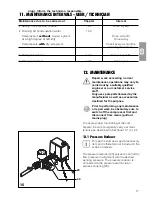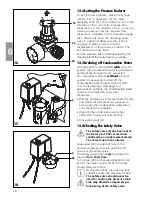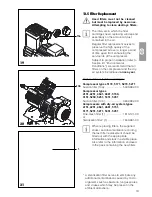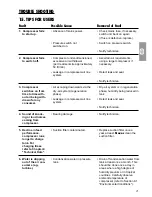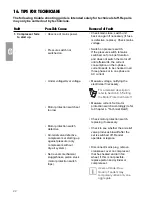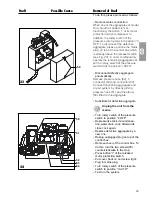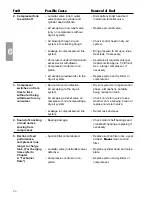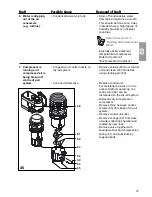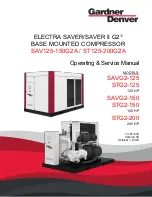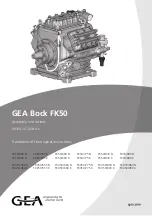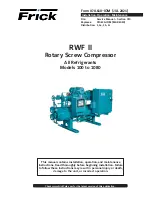
10
Description".
ASSEMBLY
7. STORAGE AND TRANSPORT
CONDITIONS
The compressor leaves the factory
packed in a transport carton which
serves to prevent damage to the unit in
transit.
For transportation, always use the
original packing materials of the
compressor where possible. Always
transport the compressor upright.
When transporting the compressor
protect against damp, dirt and extreme
temperatures.
Compressors packed in original cartons
can be stored in warm and dry rooms
not exposed to dust.
As far as possible store the packing
materials in a safe place.
If storage of the packing materials is not
possible, ensure that they are disposed
of in a manner serving to protect the
environment. The transport carton can
be disposed of in the paper recycling
bin.
The compressor must always be
transported in the depressurised
state.
Prior to transport evacuate all air
from the pressure tank and pressure
hoses and definitely drain off
condensation water that is present
(refer to Section 8.8 "Draining Off
Condensation Water").
8. INSTALLATION AND PLACING
IN INITIAL SERVICE
On compressors assigned to Test
Group 3 according to German Pres-
sure-tank Regulations, e.g., models
Trio 5351-01 or Quattro 5451-51,
installation and initial placing in
service must only be carried out by a
suitably qualified engineer who is
required to provide an appropriate
record documenting such installation
in the form of an Installation
Certificate and to enclose this
document along with the other
compressor records.
Prior to placing in service for the
first time, all transport security
devices must be removed.
8.1 Environmental Conditions
• The unit may only be installed and operated
in dry rooms that are well ventilated and free
of dust.
• The compressor must be installed in such a
way that ease of access is warranted for
operation and maintenance as well as for the
rating plate.
• The unit must be mounted on a level floor
base revealing adequate stability. Observe
weight of compressor (refer to Chapter 4.
"Technical Data").
The suction side of the air filter as
well as the ventilation slats must be
kept unobstructed and reveal ad-
equate spacing distance away from
walls (approx. 20 cm).
The mains connection line and the
air hoses must not reveal any bends
or kinks.
The room temperature must not be allowed to
fall below +10 °C as otherwise proper
functioning of the compressor will not be
warranted on account of the possibility of
undesirable condensation.
The room temperature must not be allowed to
40 °C. If room temperatures exceed
+40 °C provision must be made for additional
means of ventilation by a fan (see Fig. 3).
The ideal room temperature is from +10°C to
+25 °C.
Due to technical reasons, approx.
70 % of the electricity consumed by
the compressor set is converted to
heat and released into the environment.
The motor fan caters for effective ducted
cooling of the unit. To ensure this, the air must
be allowed to flow in and away without
obstruction of any kind. In unfavorable cases
or circumstances a forced ventilation system
will need to be installed (see Fig. 3).
No objects of any kind must be
allowed to come into contact with
the compressor since, at a room
temperature of, e.g., +40 °C, the
cylinders and cylinder heads are
liable to heat up to temperatures
exc110 °C.

















